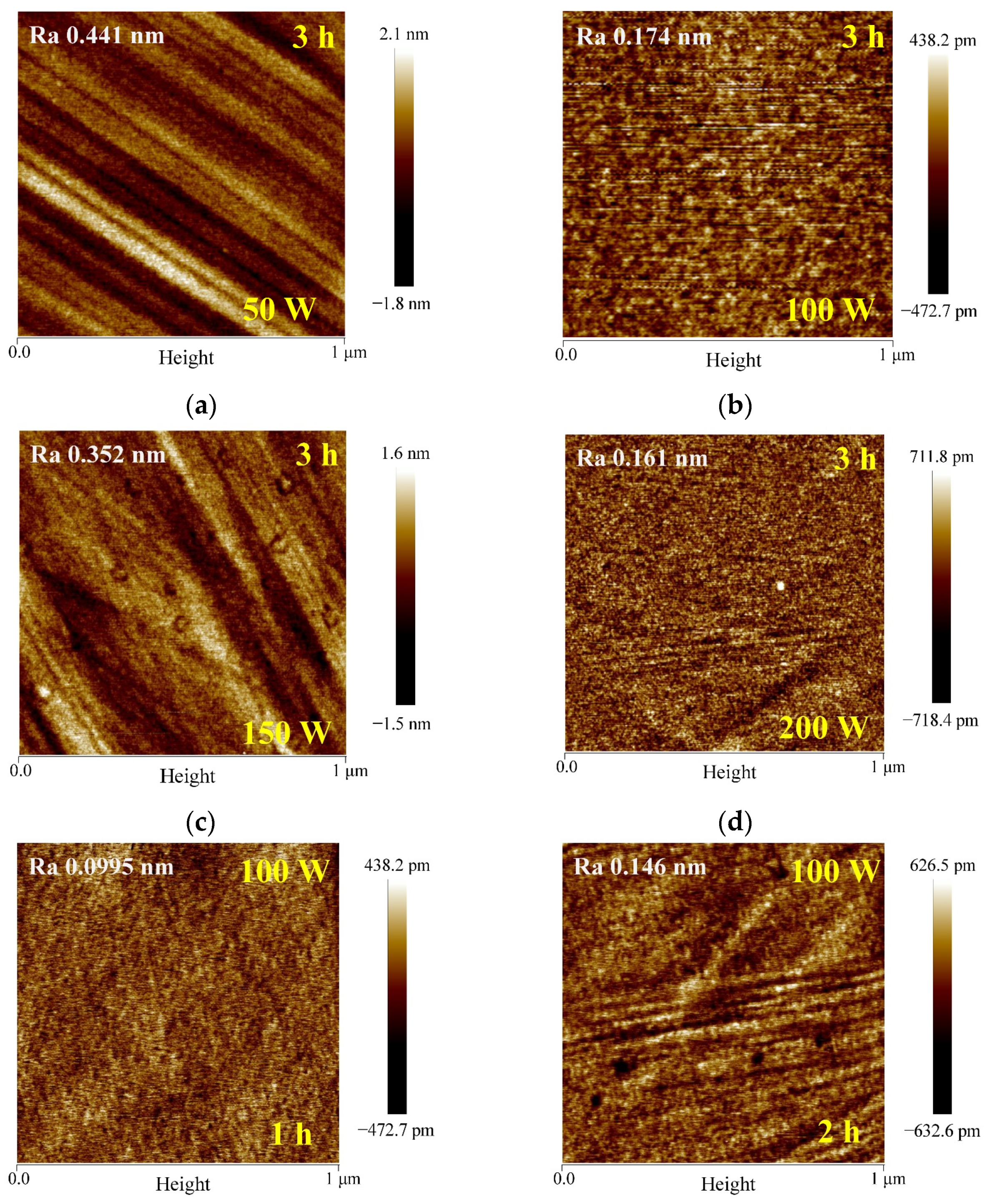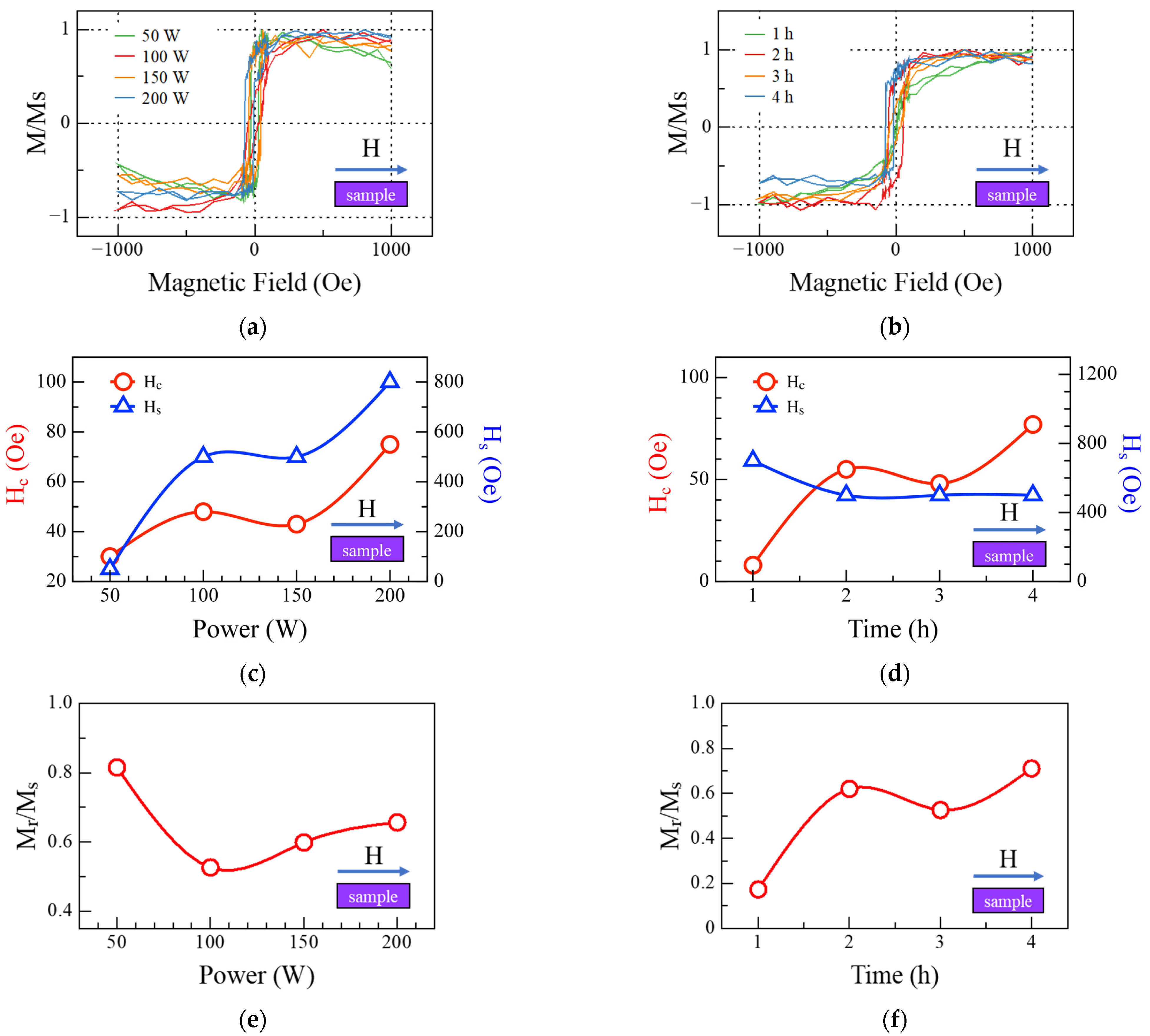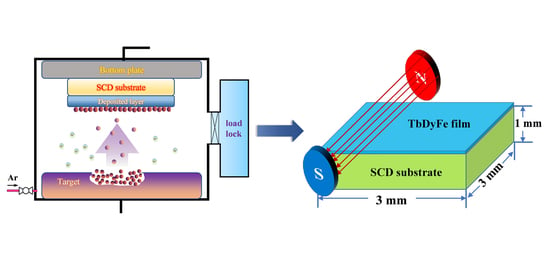Microstructure and Magnetic Properties Dependence on the Sputtering Power and Deposition Time of TbDyFe Thin Films Integrated on Single-Crystal Diamond Substrate
Abstract
:1. Introduction
2. Materials and Methods
2.1. Fabrication and Treatment of SCD Substrates
2.2. Deposition of TbDyFe
2.3. Characterization Method
3. Results and Discussion
3.1. SCD Substrate Characterization
3.2. TbDyFe Phase Composition
3.3. TbDyFe Microstructure
3.4. Magnetic Properties of TbDyFe
4. Conclusions
Author Contributions
Funding
Data Availability Statement
Conflicts of Interest
References
- Leung, C.M.; Li, J.; Viehland, D.; Zhuang, X. A review on applications of magnetoelectric composites: From heterostructural uncooled magnetic sensors, energy harvesters to highly efficient power converters. J. Phys. D Appl. Phys. 2018, 51, 263002. [Google Scholar] [CrossRef]
- Zhang, Z.; Sang, L.; Huang, J.; Chen, W.; Wang, L.; Takahashi, Y.; Mitani, S.; Koide, Y.; Koizumi, S.; Liao, M. Enhanced magnetic sensing performance of diamond MEMS magnetic sensor with boron-doped FeGa film. Carbon 2020, 170, 294–301. [Google Scholar] [CrossRef]
- Jang, J.; Choi, H.H.; Paik, S.H.; Kim, J.K.; Chung, S.; Park, J.H. Highly Improved Switching Properties in Flexible Aluminum Oxide Resistive Memories Based on a Multilayer Device Structure. Adv. Electron. Mater. 2018, 4, 1800355. [Google Scholar] [CrossRef]
- Lin, N.; Lin, Y.; Wu, G.; Chen, X.; Zhang, Z.; Hu, X.; Zhuang, N. Growth of high quality Si-based (Gd2Ce)(Fe4Ga)O12 thin film and prospects as a magnetic recording media. J. Alloys Compd. 2021, 875, 160086. [Google Scholar] [CrossRef]
- Jacob, A.A.; Balakrishnan, L.; Meher, S.R.; Shambavi, K.; Alex, Z.C. Structural, optical and photodetection characteristics of Cd alloyed ZnO thin film by spin coating. J. Alloys Compd. 2017, 695, 3753–3759. [Google Scholar] [CrossRef]
- Yu, M.; Gao, F.; Hu, Y.; Wang, L.; Hu, P.; Feng, W. Tunable electronic properties of multilayer InSe by alloy engineering for high performance self-powered photodetector. J. Colloid Interface Sci. 2020, 565, 239–244. [Google Scholar] [CrossRef]
- Li, Z.; Zhao, Y.; Li, W.; Peng, Y.; Zhao, W.; Wang, Z.; Shi, L.; Fei, W. A self-powered flexible UV-visible photodetector with high photosensitivity based on BiFeO3/XTiO3 (Sr, Zn, Pb) multilayer films. J. Mater. Chem. A 2022, 10, 8772–8783. [Google Scholar] [CrossRef]
- Shabbir, M.W.; Leuenberger, M.N. Theoretical Model of a Plasmonically Enhanced Tunable Spectrally Selective Infrared Photodetector Based on Intercalation-Doped Nanopatterned Multilayer Graphene. ACS Nano 2022, 16, 5529–5536. [Google Scholar] [CrossRef]
- Youngblood, N.; Chen, C.; Koester, S.J.; Li, M. Waveguide-integrated black phosphorus photodetector with high responsivity and low dark current. Nat. Photonics 2015, 9, 247–252. [Google Scholar] [CrossRef] [Green Version]
- Tan, Z.-Q.; Chen, Y.-C. Size-dependent electro-thermo-mechanical analysis of multilayer cantilever microactuators by Joule heating using the modified couple stress theory. Compos. Part B Eng. 2019, 161, 183–189. [Google Scholar] [CrossRef]
- Li, X.; Wang, Y.; Xu, B.; Zhou, X.; Men, C.; Tian, Z.; Mei, Y. Rolled-up single-layered vanadium oxide nanomembranes for microactuators with tunable active temperature. Nanotechnology 2019, 30, 354003. [Google Scholar] [CrossRef] [PubMed]
- Wei, Z.; Lo, C.; Liu, D.; Hsieh, Y.; Lee, Y.; Shiao, H.; Chiu, Y.; Lee, C.; Liao, C.; Chen, Y.; et al. Hysteresis in a Microactuator with Single-Domain Magnetic Thin Films. IEEE Trans. Magn. 2010, 46, 630–633. [Google Scholar] [CrossRef]
- Han, D.; Shinshi, T.; Azuma, N.; Kadota, S. An in-plane, large-stroke, multipole electromagnetic microactuator realized by guideways stacking mechanism. Sens. Actuators A Phys. 2019, 298, 111563. [Google Scholar] [CrossRef]
- Auciello, O.; Aslam, D.M. Review on advances in microcrystalline, nanocrystalline and ultrananocrystalline diamond films-based micro/nano-electromechanical systems technologies. J. Mater. Sci. 2021, 56, 7171–7230. [Google Scholar] [CrossRef]
- Shen, X.; Lv, Z.; Ichikawa, K.; Sun, H.; Sang, L.; Huang, Z.; Koide, Y.; Koizumi, S.; Liao, M. Stress effect on the resonance properties of single-crystal diamond cantilever resonators for microscopy applications. Ultramicroscopy 2022, 234, 113464. [Google Scholar] [CrossRef]
- Shen, X.; Wu, K.; Sun, H.; Sang, L.; Huang, Z.; Imura, M.; Koide, Y.; Koizumi, S.; Liao, M. Temperature dependence of Young’s modulus of single-crystal diamond determined by dynamic resonance. Diamond Relat. Mater. 2021, 116, 108403. [Google Scholar] [CrossRef]
- Yang, B.; Murooka, T.; Mizuno, K.; Kim, K.; Kato, H.; Makino, T.; Ogura, M.; Yamasaki, S.; Schmidt, M.E.; Mizuta, H.; et al. Vector Electrometry in a Wide-Gap-Semiconductor Device Using a Spin-Ensemble Quantum Sensor. Phys. Rev. Appl. 2020, 14, 044049. [Google Scholar] [CrossRef]
- Broadway, D.A.; Dontschuk, N.; Tsai, A.; Lillie, S.E.; Lew, C.T.K.; McCallum, J.C.; Johnson, B.C.; Doherty, M.W.; Stacey, A.; Hollenberg, L.C.L.; et al. Spatial mapping of band bending in semiconductor devices using in situ quantum sensors. Nat. Electron. 2018, 1, 502–507. [Google Scholar] [CrossRef]
- Masante, C.; Kah, M.; Hébert, C.; Rouger, N.; Pernot, J. Non-Volatile Photo-Switch Using a Diamond pn Junction. Adv. Electron. Mater. 2022, 8, 2100542. [Google Scholar] [CrossRef]
- Zhang, L. Filler metals, brazing processing and reliability for diamond tools brazing: A review. J. Manuf. Process. 2021, 66, 651–668. [Google Scholar] [CrossRef]
- Jin, T.; Ma, M.; Li, B.; Gao, Y.; Zhao, Q.; Zhao, Z.; Chen, J.; Tian, Y. Mechanical polishing of ultrahard nanotwinned diamond via transition into hard sp2-sp3 amorphous carbon. Carbon 2020, 161, 1–6. [Google Scholar] [CrossRef]
- Yue, Y.; Gao, Y.; Hu, W.; Xu, B.; Wang, J.; Zhang, X.; Zhang, Q.; Wang, Y.; Ge, B.; Yang, Z.; et al. Hierarchically structured diamond composite with exceptional toughness. Nature 2020, 582, 370–374. [Google Scholar] [CrossRef] [PubMed]
- Zhang, Z.; Wu, H.; Sang, L.; Huang, J.; Takahashi, Y.; Wang, L.; Imura, M.; Koizumi, S.; Koide, Y.; Liao, M. Single-crystal diamond microelectromechanical resonator integrated with a magneto-strictive galfenol film for magnetic sensing. Carbon 2019, 152, 788–795. [Google Scholar] [CrossRef]
- Zhang, Z.; Sang, L.; Huang, J.; Wang, L.; Koizumi, S.; Liao, M. Tailoring the magnetic properties of galfenol film grown on single-crystal diamond. J. Alloys Compd. 2021, 858, 157683. [Google Scholar] [CrossRef]
- Zhu, L.; Li, K.; Luo, Y.; Yu, D.; Wang, Z.; Wu, G.; Xie, J.; Tang, Z. Magnetostrictive properties and detection efficiency of TbDyFe/FeCo composite materials for nondestructive testing. J. Rare Earths 2019, 37, 166–170. [Google Scholar] [CrossRef]
- Wang, N.; Liu, Y.; Zhang, H.; Chen, X.; Li, Y. Effect of Co, Cu, Nb, Ti, V on magnetostriction and mechanical properties of TbDyFe alloys. Intermetallics 2018, 100, 188–192. [Google Scholar] [CrossRef]
- Dong, D.; Qian, J.; Huang, Y.; Shi, Y.; Tang, S.; Du, Y. Giant magnetostriction in TbDyFe/epoxy composites with spherical single-crystal particles. J. Alloys Compd. 2022, 917, 165558. [Google Scholar] [CrossRef]
- Shen, X.; Sun, H.; Sang, L.; Imura, M.; Koide, Y.; Koizumi, S.; Liao, M. Integrated TbDyFe Film on a Single-Crystal Diamond Microelectromechanical Resonator for Magnetic Sensing. Phys. Status Solidi RRL—Rapid Res. Lett. 2021, 15, 2100352. [Google Scholar] [CrossRef]
- Wang, J.; Kuang, S.; Yu, X.; Wang, L.; Huang, W. Tribo-mechanical properties of CrNbTiMoZr high-entropy alloy film synthesized by direct current magnetron sputtering. Surf. Coat. Technol. 2020, 403, 126374. [Google Scholar] [CrossRef]
- Basumatary, H.; Arout Chelvane, J.; Sridhara Rao, D.V.; Kamat, S.V.; Ranjan, R. Effect of sputtering parameters on the structure, microstructure and magnetic properties of Tb-Fe films. Thin Solid Film. 2015, 583, 1–6. [Google Scholar] [CrossRef]
- Ni, J.; Li, J.; Jian, J.; He, J.; Chen, H.; Leng, X.; Liu, X. Recent Studies on the Fabrication of Multilayer Films by Magnetron Sputtering and Their Irradiation Behaviors. Coatings 2021, 11, 1468. [Google Scholar] [CrossRef]
- Li, H.; Li, C.; Jia, H.; Chen, G.; Li, S.; Chen, K.; Wang, C.; Qiao, L. Facile fabrication of cordierite-based porous ceramics with magnetic properties. J. Adv. Ceram. 2022, 11, 1583–1595. [Google Scholar] [CrossRef]
- Mohanchandra, K.P.; Prikhodko, S.V.; Wetzlar, K.P.; Sun, W.Y.; Nordeen, P.; Carman, G.P. Sputter deposited Terfenol-D thin films for multiferroic applications. AIP Adv. 2015, 5, 097119. [Google Scholar] [CrossRef] [Green Version]
- More-Chevalier, J.; Cibert, C.; Domengès, B.; Ferri, A.; Desfeux, R.; Bouregba, R.; Poullain, G. Microstructure and magnetic properties dependence on the thickness of Tbx Dy1−x Fe2 thin films sputtered on Pt/TiO2/SiO2/Si substrate. Thin Solid Film. 2017, 623, 138–146. [Google Scholar] [CrossRef]
- Yan, J.; Wang, Y.; Wang, C.; Ouyang, J. Boosting energy storage performance of low-temperature sputtered CaBi2Nb2O9 thin film capacitors via rapid thermal annealing. J. Adv. Ceram. 2021, 10, 627–635. [Google Scholar] [CrossRef]
- Arenal, R.; Montagnac, G.; Bruno, P.; Gruen, D.M. Multiwavelength Raman spectroscopy of diamond nanowires present inn-type ultrananocrystalline films. Phys. Rev. B 2007, 76, 245316. [Google Scholar] [CrossRef]
- Long, D.A. Raman Spectroscopy; McGraw-Hill: New York, NY, USA, 1977; Volume 1. [Google Scholar]
- Lee, H.-S.; Cho, C. Study on advanced multilayered magnetostrictive thin film coating techniques for MEMS application. J. Mater. Process. Technol. 2008, 201, 678–682. [Google Scholar] [CrossRef]
- Epp, J. X-ray diffraction (XRD) techniques for materials characterization. In Materials Characterization Using Nondestructive Evaluation (NDE) Methods; Woodhead Publishing: Bremen, Germany, 2016; pp. 81–124. [Google Scholar]
- Rowe, M.C.; Brewer, B.J. AMORPH: A statistical program for characterizing amorphous materials by X-ray diffraction. Comput. Geosci. 2018, 120, 21–31. [Google Scholar] [CrossRef] [Green Version]
- Holzwarth, U.; Gibson, N. The Scherrer equation versus the ‘Debye-Scherrer equation’. Nat. Nanotechnol. 2011, 6, 534. [Google Scholar] [CrossRef]
- Liu, X.; Yang, Q.; Zhang, D.; Wu, Y.; Zhang, H. Magnetic properties of bismuth substituted yttrium iron garnet film with perpendicular magnetic anisotropy. AIP Adv. 2019, 9, 115001. [Google Scholar] [CrossRef]






| Theme | Processing Parameters | |||
|---|---|---|---|---|
| Power (W) | Time (h) | Working Pressure (Pa) | Ar Flow (sccm) | |
| Power effect | 50 | 3 | 0.8 | 10 |
| 100 | ||||
| 150 | ||||
| 200 | ||||
| Deposition time effect | 100 | 1 | ||
| 2 | ||||
| 3 | ||||
| 4 | ||||
| Processing Parameters | Diffraction Angle (°) | FWHM (Radian) | Grain Size (nm) |
|---|---|---|---|
| 150 W, 3 h | 22.21 | 0.0035 | 42.34 |
| 200 W, 3 h | 22.25 | 0.0089 | 16.63 |
| 100 W, 4 h | 22.27 | 0.0079 | 18.87 |
Publisher’s Note: MDPI stays neutral with regard to jurisdictional claims in published maps and institutional affiliations. |
© 2022 by the authors. Licensee MDPI, Basel, Switzerland. This article is an open access article distributed under the terms and conditions of the Creative Commons Attribution (CC BY) license (https://creativecommons.org/licenses/by/4.0/).
Share and Cite
Lv, Z.; Shen, X.; Guo, J.; Cao, Y.; Lan, C.; Ke, Y.; Yang, Y.; Qi, J. Microstructure and Magnetic Properties Dependence on the Sputtering Power and Deposition Time of TbDyFe Thin Films Integrated on Single-Crystal Diamond Substrate. Processes 2022, 10, 2626. https://doi.org/10.3390/pr10122626
Lv Z, Shen X, Guo J, Cao Y, Lan C, Ke Y, Yang Y, Qi J. Microstructure and Magnetic Properties Dependence on the Sputtering Power and Deposition Time of TbDyFe Thin Films Integrated on Single-Crystal Diamond Substrate. Processes. 2022; 10(12):2626. https://doi.org/10.3390/pr10122626
Chicago/Turabian StyleLv, Zhenfei, Xiulin Shen, Jinxuan Guo, Yukun Cao, Chong Lan, Yanghui Ke, Yixian Yang, and Junyi Qi. 2022. "Microstructure and Magnetic Properties Dependence on the Sputtering Power and Deposition Time of TbDyFe Thin Films Integrated on Single-Crystal Diamond Substrate" Processes 10, no. 12: 2626. https://doi.org/10.3390/pr10122626







